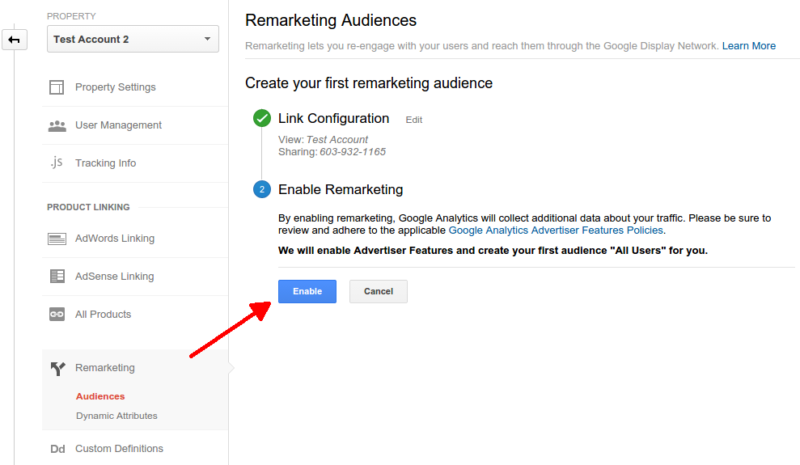Optimize Your ROI With Remarketing in Google Analytics
In the world of digital advertising and marketing, the use of remarketing strategies within Google Analytics has actually confirmed to be a potent tool for improving roi. By harnessing the power of user data and tailoring ads to certain audience sections, organizations can substantially magnify their conversion rates. Nonetheless, the genuine key hinge on the art of accuracy - recognizing individual actions, crafting engaging ads, and continuously refining strategies to drive optimum results. The trip to maximizing ROI via remarketing is a nuanced path led with understandings and chances that can reshape the trajectory of your marketing ventures.
Comprehending Remarketing in Google Analytics
Understanding remarketing in Google Analytics is essential for maximizing your digital marketing technique. Remarketing enables you to target individuals who have actually previously seen your internet site or communicated with your app, providing them with tailored advertisements as they surf various other websites or utilize other apps within the Google Present Network. This strategy assists maintain your brand top of mind and urges individuals to return to your site, ultimately increasing the probability of conversion.
By making use of Google Analytics, you can track the efficiency of your remarketing projects, gaining beneficial understandings right into user habits, engagement, and conversions. This data enables you to refine your targeting, messaging, and bidding methods to boost the overall performance of your projects.
In addition, recognizing the various sorts of remarketing checklists available in Google Analytics, such as standard, dynamic, and similar audiences, allows you to create customized and highly fractional campaigns tailored to specific customer sectors. This degree of granularity can considerably boost the significance and effect of your remarketing efforts, eventually optimizing your return on investment.
Establishing Remarketing Lists
To efficiently apply remarketing campaigns in Google Analytics, the preliminary action entails creating and setting up remarketing lists targeting certain user sectors based on their communications with your site or application. By establishing up remarketing lists, you can tailor your advertising efforts to reach users that have actually already revealed rate of interest in your services or items.
To start, browse to the Admin section of your Google Analytics account and pick the Home where you want to produce the remarketing listing. Under the Home column, click on 'Audience Definitions' and pick 'Target markets.' Next off, click on the red 'New Target market' button and pick 'Develop New' to specify the criteria for your remarketing checklist.

Crafting Efficient Remarketing Advertisements

When crafting your advertisements, concentrate on creating eye-catching headings and engaging visuals that attract attention to possible consumers. Integrate solid calls-to-action that urge individuals to revisit your website and finish a desired activity. Make use of dynamic remarketing to show customized ads featuring service or products that individuals have previously watched on your site.
Furthermore, guarantee that your advertisements are mobile-friendly since a considerable part of internet web traffic comes from mobile devices. Examination different ad variations to identify which styles and messages drive the very best outcomes. By continually refining and enhancing your remarketing advertisements based on performance data, you can maximize their efficiency and enhance your roi.
Analyzing Remarketing Efficiency

Via Google Analytics, marketing professionals can track the efficiency of their remarketing projects in real-time, allowing them to identify fads, patterns, and locations for improvement immediately. By examining the data, marketing experts can identify which ads are carrying out well, which audience segments are reacting favorably, and which networks are driving one of the most conversions. This degree of granularity makes it possible for marketing experts to make data-driven decisions to enhance their remarketing projects for better outcomes.
Enhancing ROI With Remarketing
Assessing remarketing data in Google Analytics makes it possible for online marketers to determine opportunities for maximizing return on financial investment (ROI) with critical changes - What Is “Remarketing” In Google Analytics?. To make the most of ROI with remarketing, it is crucial to comprehend the actions of your target market. By analyzing customer interactions, such as the pages they checked out, the products they viewed, or the actions they handled your website, you can customize your remarketing campaigns much more successfully
Segmenting your target market based on their habits allows you to produce personalized and targeted ads that are most likely to resonate with them. By revealing appropriate ads to certain sections of your audience, you can raise the chances of conversion and eventually enhance your ROI.
In addition, checking different advertisement creatives, messaging, and offers can aid determine what resonates finest with your target market. A/B testing enables you to try out different elements of your ads to establish what drives the highest involvement and conversion prices.
Conclusion
To conclude, making the most of ROI with remarketing in Google Analytics needs a tactical method to evaluating individual actions, segmenting target markets, developing customized ads, and maximizing project efficiency. By leveraging data-driven insights and examining various techniques, companies can improve their remarketing efforts to drive greater engagement and conversion prices. This methodical method ensures that resources are successfully assigned in the direction of making best use of returns on financial investment in remarketing projects.
Next, click on the red 'New Target market' switch and choose 'Produce New' to define the specifications for your remarketing list.
By continually refining and optimizing your remarketing advertisements based on efficiency data, you can optimize their efficiency and visit their website enhance your return on investment.
By delving right into these insights, online marketers can acquire an extensive understanding of how their remarketing initiatives are resonating with their target read what he said audience and driving conversions. To optimize ROI with remarketing, it is crucial to comprehend the actions of your audience.In final thought, making the most of ROI with remarketing in Google Analytics needs a critical approach to assessing individual behavior, segmenting target markets, developing tailored advertisements, and enhancing project performance.